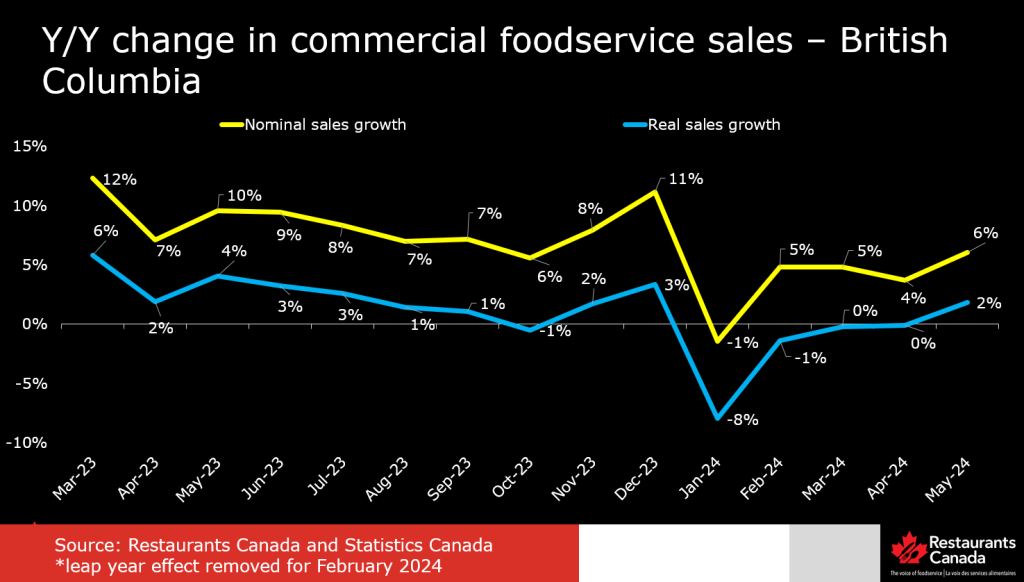A couple of years after COVID-19 pandemic-related restrictions were lifted, B.C.’s restaurant industry continues to struggle to find its footing.
Numbers from the Office of the Superintendent of Bankruptcy show there have been hundreds of closures across the country since 2021, including hundreds in B.C.

(Courtesy Restaurants Canada)
“Certainly, if you’re looking for restaurants that have closed their doors, there have certainly been a lot of those,” explained Mark von Schellwitz, vice president of Western Canada for Restaurants Canada.
“The first quarter of this year was the highest number of restaurant bankruptcies we’ve ever had and, of course, they’re still pretty high for the rest of the year.”
He adds there are a few reasons for the downfall. One of them is high interest rates, which are now coming down, and “cost increases of over 20 per cent,” which has led to increased menu prices.
“Our guests are spending less money when they go out to restaurants because they have to tighten their belts as well. It’s been a very challenging time and if you’re looking to enter the restaurant business, there are certainly some good opportunities out there right now,” he explained.
“We just hope there are more of those people because right now our restaurant industry is actually shrinking in B.C. We’re opening fewer new restaurants than we’re closing.”
Von Schellwitz points out that coming out of the height of the pandemic, many owners were carrying a lot of debt.
“Our guests did come out in 2022 and came back out to our restaurants, but unfortunately, all the economic situations that we’re facing with rising costs have also hit our guests and we’ve seen those guest counts drop considerably and sales have dropped off,” he said.
“… I think before the pandemic, maybe 12 per cent of the industry wasn’t making any money … [and] that number now is over 50 per cent of the industry not being profitable.”
He says as they deal with closures, there’s a decent chance what was once a restaurant will return as something else.
“We’re seeing more and more closures, and not just bankruptcies, but with leases expiring, landlords are often asking for rent increases, which are just completely unsustainable, so you’re seeing restaurants close their doors because they just can’t afford those new lease costs,” he said.
“And especially with those new lease rates, if it’s not viable for a restaurant to be profitable in that space, you’re going to see that go to retail or to some other usage.”

(Courtesy Restaurants Canada)
Ian Tostenson is president and CEO of the BC Restaurant Food Services Association. He echoes von Schellwitz’s concerns about the future of the industry and trying to offload a dying restaurant.
“The formula is what is the value of your assets? Your chairs, your tables, all your equipment, generally, it’s been quite depreciated. It’s pennies to the dollar.”
He claims menu prices have only gone up seven per cent, despite costs going up 20 per cent over the last year. He blames the downturn on more people who seem to be staying home or choosing take-out instead.
“The other factor we’re seeing is the effect of things like Uber Eats and Skip the Dishes and that’s about 30 per cent of the market now. But what happens is people are having great experiences having food delivered to their homes, but they’re not incrementally buying the bottle of wine or the whatever,” he explained.
“As much as it was a lifesaver during the pandemic, it’s actually hurt us a bit. There’s another trend that’s really interesting is that there is a move towards people drinking less, particularly the younger demographic, not so much the older demographic.”
Tostenson says having the NHL play return will hopefully help following a soft summer of sales.
In B.C., Tostenson confirms there are about 15,000 eateries that employ roughly 200,000 people. However, he adds there’s a labour shortage of about 20,000 people as annual sales hit $18 billion.
Despite all this, both feel things will turn around starting late this year or by at least spring 2025.